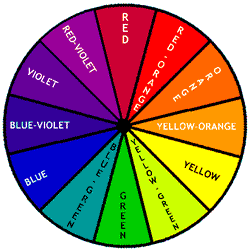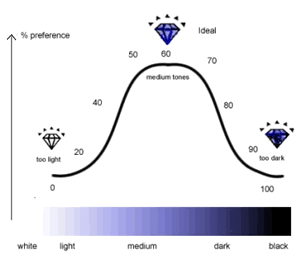Gemstone Color - A Quick Guide to Colors
A gemstone's color is its most defining and arguably a stone's most important characteristic. When deciding upon gemstone color you should consider hue, tone, and saturation.
Hue

Hue refers to the position of a color on the color wheel. There are six primary hues: violet, blue, green, yellow, orange, and red. Between these primary hues are secondary hues, such as blue-green. Some stones have mixed hues. For example, sapphires can have a hue ranging from "slightly purplish-blue" to "slightly greenish-blue," and rubies range from "slightly orangish-red" to "slightly purplish-red". Gemstones that have mostly pure primary colors are the most valuable. These stones will have only a slight touch of other colors in the wheel.
Tone
Tone (also known as value or lightness) refers to the relative lightness or darkness of color. Another way of thinking of tone is as the percentage of light absorbed by a color. A stone that absorbs no color is white, while a stone that absorbs all light is black.
Saturation
Saturation (also known as chroma or intensity) refers to the amount of color present. Saturation is the most important color-grading factor.
To help visualize saturation, imagine a glass of water. Slowly blue ink is added to the water in the glass. The color will gradually become a deeper blue. In other words, the saturation increases proportionally with the amount of ink in the water. An example would be a ruby that was as red as it possibly could be. This ruby has obtained maximum saturation. A ruby with the lightest shade of pink possible would have the minimum saturation possible.
Tone
To help visualize tone, imagine two glasses each filled with water. Add two drops of colored ink into each glass. The two glasses will now have identical hue and tone.
 Now add two more drops of ink to only one glass. The hue is the same, but now this glass has a higher tone and saturation. If you continue to add ink to this glass, the tone and saturation will increase, but only to a point. Adding too much ink will eventually darken the color so much that black overrides the hue, resulting in a decrease in saturation.
Now add two more drops of ink to only one glass. The hue is the same, but now this glass has a higher tone and saturation. If you continue to add ink to this glass, the tone and saturation will increase, but only to a point. Adding too much ink will eventually darken the color so much that black overrides the hue, resulting in a decrease in saturation.
Overall, stones that have light or dark tones are less desirable than those of medium tones. However, remember that the ideal tone depends on the hue. The highest saturation of yellow will always be lighter than the highest saturation of orange, which itself is lighter than the highest green or red, which is lighter than the highest blue or purple.
- العربية | لون الأحجار الكريمة - دليل سريع للألوان
- 中文 | 宝石颜色 - 颜色快速指南
- Français | Couleur des pierres précieuses - Un guide rapide des couleurs
- Deutsch | Edelsteinfarbe – Eine Kurzanleitung zu Farben
- Italiano | Colore delle pietre preziose: una guida rapida ai colori
- 日本語 | 宝石の色 - 色のクイックガイド
- 한국인 | 보석 색상 - 색상에 대한 빠른 가이드
- Português | Cor de pedra preciosa - um guia rápido para cores
- Pусский | Цвет драгоценных камней — краткое руководство по цветам
- Español | Color de piedras preciosas: una guía rápida de colores






